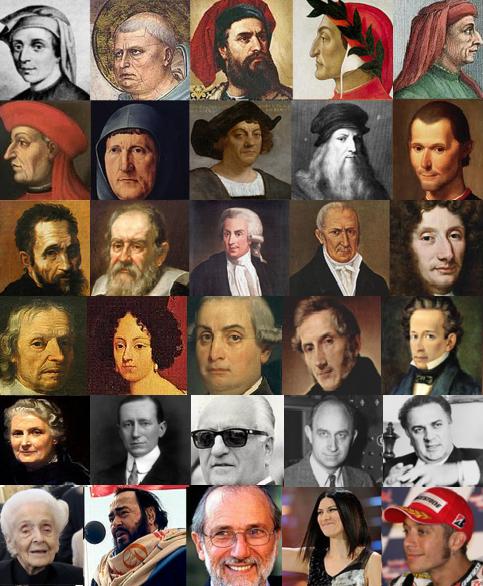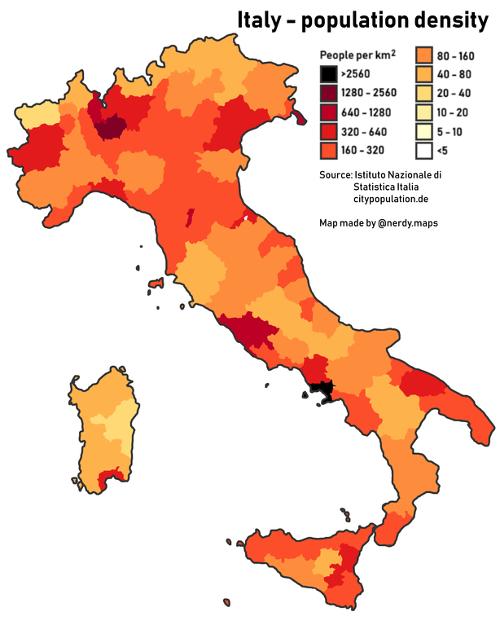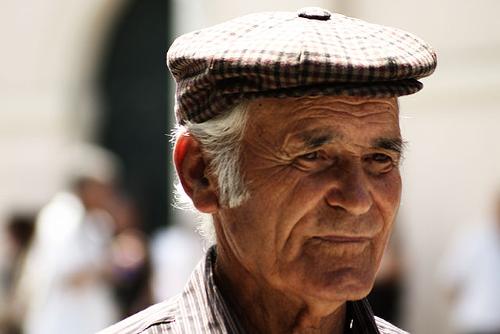ITALY
Population

Population

Cities in ITALY
| Bologna | Florence | Milan |
| Naples | Rome | Trieste |
| Venice | Verona |
Popular destinations ITALY
| Campania | Lombardy | Sardinia |
| Sicily | Tuscany | Umbria |
| Veneto |
Population
The population of Italy originated from the amalgamation of various peoples and includes Etruscan, Gallic, Italic, Punic and Germanic elements. In the late 19th and early 20th century, the rapid growth of the Italian population led to a large wave of emigration. The Northern Italians mainly moved to Central and Western Europe, the Central and Southern Italians left for the United States, Brazil and (especially) Argentina. However, many emigrants returned to their native country after a number of years. Emigration decreased in the 1930s. After the Second World War, it increased again, albeit of a considerably lesser extent. Since 1983, however, immigration has outpaced emigration. Between 1860 and 1973, 26 million Italians emigrated to other countries, mainly to North and South America. Famous Italians through the agesPhoto: 115ash CC 4.0 International no changes made
Famous Italians through the agesPhoto: 115ash CC 4.0 International no changes made
Illegal immigration through southern Italian ports and beaches, mostly from Albania and Turkey, is still significant. In April 2000, the Italian and Albanian governments reached an agreement on the annual admission of 5000 Albanians into Italy.
In addition to emigration, there was also extensive internal migration during the rapid economic growth after the Second World War; Part of the rural population, especially in the south, has moved mainly to the industrial areas of Turin, Genoa and Milan in the north. Hundreds of thousands of migrants also fled to Naples and Rome .
The population of Italy in 2017 was 62,137,1802 million. The population density is approximately 206 inhabitants per km2. Population density Italy by province (2020)Photo: Nerdy.maps CC 4.0 International no changes made
Population density Italy by province (2020)Photo: Nerdy.maps CC 4.0 International no changes made
Population development
1901 33.778.000
1911 36.921.000
1921 37.856.000
1931 41.043.000
1936 42.399.000
1951 47.516.000
1961 50.624.000
1971 54.137.000
1981 56.557.000
1991 56.778.000
2001 57.679.825
The areas around the major cities have the highest population density. Approx. 69% of the population lives in urban areas.
Number of inhabitants in the largest cities (2017):
Rome 3.718.000
Milan 3.099.000
Naples 2.202.000
Turin 1.765.000
Palermo 853.000
Large parts of the population live in Lombardy, Campania and Lazio. Molise and Aosta Valley, on the other hand, are home to a much smaller portion of the population.
Until the 1970s, Italy had a strong natural population growth. In the period from 1986 to 1988, the birth rate averaged 9.9 percent and the mortality rate 9.4 percent, resulting in a natural population growth of 0.5 per 1,000 inhabitants. In the period 1990 to 1995, the Italian population has grown by 0.1 percent per year. Natural population growth in the period 1998 to 2015 amounts to 0.3% per year. In 2017 the population growth was 0.17%
The birth rate is much higher in the poor agricultural south than in the prosperous industrial north. Here the population is also much more influenced by the ideas of the Roman Catholic Church.
The population is also getting older; in 2017 only 13.6% was younger than 15 years old; 21.5 of the population was over 65 years old.
Life expectancy at birth was 79.6 years for men and 85.1 years for women in 2017.
Age structure of population (2017):
00-15 jaar 13,65%
15-24 jaar 9,66%
25-54 jaar 42,16%
55-64 jaar 12,99%
65+ jaar 21.53% Elderly Sardinian man, ItalyPhoto: Jean Bajean CC Alike 2.5 Generic no changes made
Elderly Sardinian man, ItalyPhoto: Jean Bajean CC Alike 2.5 Generic no changes made
Sources
Cassidy, P. / Italy
Raintree Steck-Vaughn Publishers
Europa
Lekturama
Europese Unie : vijftien landendocumentaties
Europees Platform voor het Nederlandse Onderwijs
Jepson, T. / Italië
Van Reemst
The Statesman's Yearbook: the politics, cultures and economies of the world
Macmillan Press
CIA - World Factbook
BBC - Country Profiles
Copyright: Team The World of Info